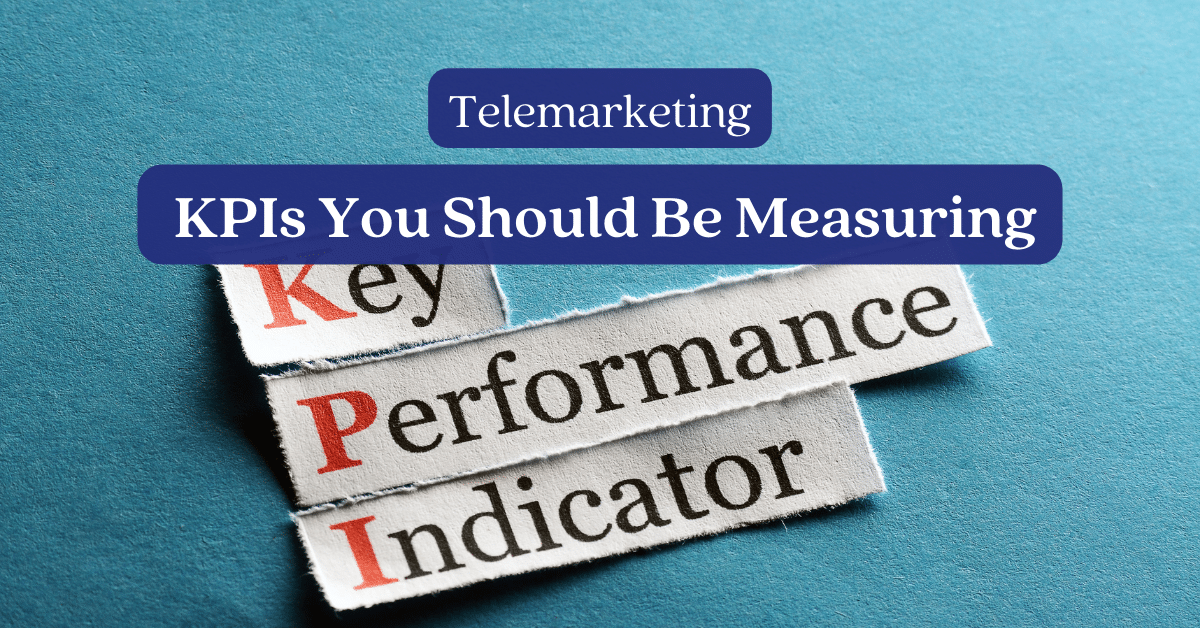Telemarketing: KPIs You Should Be Measuring
Telemarketing is a powerful tool for outbound marketing when it comes to generating B2B leads. That’s why it is important to understand what to measure when it comes to key performance indicators (KPIs) for your campaigns. Simply put, you can’t tell how a campaign is performing if you don’t have the data.
In this blog post, we’ll explore three key KPIs you should be measuring to track your telemarketing campaign’s effectiveness. By doing so, you’ll be able to make better informed decisions to improve the success of your campaign.
What is Telemarketing?
Telemarketing is an outbound marketing tactic that involves sales teams contacting prospects by phone, also known as cold calling. The aim is to identify the pain points of prospects and provide them with relevant information about specific products or services that offer a solution.
How Do You Measure Telemarketing Effectiveness?
There are numerous ways to measure the effectiveness of telemarketing campaigns. This method of outbound marketing isn’t simply picking up the phone and selling. The truth is, sales reps might not get a hold of a prospect the first time or even at all. That’s why monitoring the right KPIs is crucial to understanding what’s working and what isn’t.
Let’s delve into the key KPIs that can make a difference to you B2B telemarketing campaigns:
KPI 1: Contact Rate
The contact rate measures the percentage of calls that successfully connect with the intended recipient. This KPI is crucial for evaluating the efficiency of your call lists, dialling methods, and contact information accuracy. For example, if your sales rep makes 150 calls, divide that number by the actual number of calls made, and you’ll have the contact rate.
Benefits of Measuring Contact Rates:
In telemarketing, contact rates can fluctuate day-to-day. However, if there is a pattern that shows the contact rate is poor (more often than not), then it will need to be investigated. That’s why it’s beneficial to measure this metric to identify any discrepancies. Below are a few benefits associated with measuring contact rates;
Resource Efficiency: Identifying high contact rate campaigns allows telemarketing companies to allocate resources effectively and reach more potential customers. As they say, time is money, so it’s best to investigate campaigns with low contact rates in order to maximise efficiency and performance.
Improved Lead Generation: Higher contact rates can correlate to more calls increasing the likelihood in generating leads and making sales. This doesn’t apply to only sales calls, but emails too. Email follow-ups are important, and with a low email bounce rate, means your team has a better chance in receiving replies from prospects.
Better Data Quality: Sometimes poor contact rates could be down to incorrect or outdated contact information. When it comes to B2B data, having up-to-date and accurate information can greatly improve contact rates, giving you the edge over the competition and improve profitability.
KPI 2: Lead Conversion Rate
The lead conversion rate is the percentage of leads generated through telemarketing efforts that convert into a sale. It’s a fundamental KPI for evaluating your sales and conversion processes. For example, if outbound telemarketing efforts generate 10 leads and 2 convert into a sale, the lead conversion rate would be 20%.
This is an important metric to measure because generating leads is one thing, but if they don’t convert, you’re wasting valuable time and money. At the Lead Generation Company, our team uses the BANT method (budget, authority, need, and timescale) to ensure our leads are fully qualified. Below are a few benefits associated with measuring lead conversion rates;
Benefits of Measuring Lead Conversion Rates:
ROI Assessment: Knowing your lead conversion rate helps you determine the return on investment from your telemarketing companies’ campaigns. You’ll have the insight to make better informed decisions, whether or not you’re getting the value for money you invested in.
Sales Performance: Telemarketing companies are able to evaluate the effectiveness of their team turning leads into customers. Partnering with an experienced B2B lead generation company will have seasoned professionals who know how to sell your product or service effectively – generating those high-quality leads.
Targeted Approach: If your campaign is targeting a specific demographic, it might not be effective to begin with. Telemarketing companies can identify areas to pivot and target industries or decision makers who would resonate more with your product or services.
KPI 3: Average Talk Time
Average talk time measures the average duration of successful calls. It indicates how engaging and productive your conversations with potential customers are. You can calculate this by measuring the total time on the call divided by the number of prospects contacted. If the overall talk time was 30 minutes when speaking to 10 prospects, the average would be 3 minutes per call.
Benefits of Measuring Average Talk Times:
When it comes to the average talk time benchmarks – it’s difficult to state. There are many factors that can influence this. By measuring average talk time per campaign, can give good insight into how long your sales reps are spending on them.
A long or short talk time can neither be good nor bad at first glance, however, this depends on how many leads can be generated. If your sales reps have a high average talk time but are generating leads – then great! However, if there are no leads being generated then this would have to be evaluated.
Below are a few benefits associated with measuring lead conversion rates;
Quality Conversations: Longer talk times may indicate more meaningful and persuasive conversations. They will involve sales reps going into more detail how your product or services can solve their pain points – resulting in appointments booked in the diary. Short talk times that deliver leads are also beneficial. It suggests that your sales reps are direct, but delivering their pitch that persuades prospects for a meeting.
Sales Rep Performance: This can help evaluate the effectiveness of your telemarketing team in engaging with leads. If their talk time is high, and with no leads to their name, then something’s wrong. By offering support to help them in their sales approach would be beneficial. For example, they might be going off track when trying to sell a product or service. With guidance, they can be more succinct and direct in their approach.
Script Optimisation: By analysing talk times, you can refine your calling scripts for better engagement. Using bullet points can make it clearer for the sales rep to deliver to prospects and keep on track. This will help sales reps deliver the solutions to the prospects pain points more effectively.
Conclusion
When it comes to telemarketing KPIs, having full visibility on both sales rep and campaign performance is paramount. Closely monitoring the contact rate, lead conversion rate, and average talk time will help you identify any areas of weakness. By using the data available, you can make the necessary adjustments to improve campaigns, or further enhance their performance.
To find out more about our B2B telemarketing and lead generation services, contact us today at 0330 808 0866 or head to our website to get in touch.

Ryan Whyte is the Senior Campaign Manager where he leads a team of B2B telemarketers to deliver high-quality leads for clients. With a strong background in campaign management and a focus on driving results, Ryan is dedicated to optimising strategies that maximise client success in B2B lead generation.



















